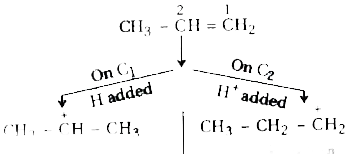Electrophilic addition reactions proceed in two steps. The first step involves the addition of an electrophile. Name of type of intermediate formed in the first step of the following addition reaction .
CH3−CH=CH2+H+→ ?
2∘ -carbanion
1∘ -carbocation
2∘-carbocation
1∘-carbanion
The correct Answer is:C

According to Marecovnicove.s rule, the 2∘ carbocation is formed and complete electrophilic addition reaction.
Topper's Solved these Questions
- ORGANIC CHEMISTRY SOME BASIC PRINCIPLES AND TECHNIQUESBOOK - KUMAR PRAKASHANCHAPTER - ORGANIC CHEMISTRY SOME BASIC PRINCIPLES AND TECHNIQUESEXERCISE - Section -D -Multiple Choice Questions (MCQs)
14 Videos
- ORGANIC CHEMISTRY SOME BASIC PRINCIPLES AND TECHNIQUESBOOK - KUMAR PRAKASHANCHAPTER - ORGANIC CHEMISTRY SOME BASIC PRINCIPLES AND TECHNIQUESEXERCISE - Section -D -Short Answer Type
54 Videos
- ORGANIC CHEMISTRY SOME BASIC PRINCIPLES AND TECHNIQUESBOOK - KUMAR PRAKASHANCHAPTER - ORGANIC CHEMISTRY SOME BASIC PRINCIPLES AND TECHNIQUESEXERCISE - Section -C - MCQs asked in JEE/NEET/AIEEE
68 Videos
- HYDROGENBOOK - KUMAR PRAKASHANCHAPTER - HYDROGENEXERCISE - Section-D NCERT Exemplar (Long Answer)
8 Videos
- QUESTION ASKED IN JEE -2018BOOK - KUMAR PRAKASHANCHAPTER - QUESTION ASKED IN JEE -2018EXERCISE - MCQ
10 Videos
Similar Questions
Electrophilic additions reactions proceed in two steps. The first step involves the additions of an electrophile. Name the type of intermediate formed in the first step of the following addition reaction H3C−HC=CH2+H+→?
View SolutionIn the adddition of HBr to propene in the absence of peroxides, the first step involves the addition of-s
View Solution
Knowledge Check
Electrophilic additions reactions proceed in two steps. The first step involves the additions of an electrophile. Name the type of intermediate formed in the first step of the following addition reaction H3C−HC=CH2+H+→?
A3∘ carbanionB1∘ carbocationC2∘ carbocationD1∘ carbanionElectrophilic addition reactions proceed in two steps. The first step involves the addition of an electrophile. Name the type of intermediate formed in the first step of the following addition reaction.
H3C−HC=CH2+H+→?A2∘ carbanionB1∘ carbocationC2∘ carbocationD1∘ carbanionElectrophilic addition reactions proceed in two steps. The first step involves the addition of an electrophile. Name the type of intermediate formed in the first step of the following addition reaction.
H3C−HC=CH2+H+→?A2∘ carbanionB1∘ carbocationC2∘ carbocationD1∘ carbanion
Electrophillic addition reaction proceed in two steps. The first step involves the addition of an electrophile. Name the type of intermediate formed in the first step of the following addition reaction.
H2C−HC=CH2+H+→ ?
View SolutionElectrophilic additions reactions proceed in two steps. The first step involves the additions of an electrophile. Name the type of intermediate formed in the first step of the following addition reaction H3C−HC=CH2+H+→?
View SolutionIn the adddition of HBr to propene in the absence of peroxides, the first step involves the addition of-s
View SolutionIn the addition of HBr to propene in the absence of peroxides, the first step involves the addition of:
View SolutionWhat is the first step in the reaction of an electrophile (E)) with benzene?
View Solution
